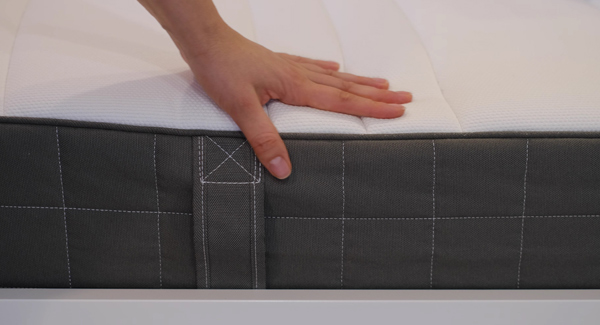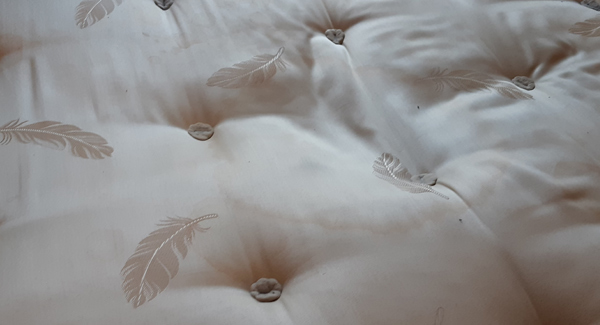Home » Mattress advice » Mattress Edge Support: What Is It & Why It Matters
Mattress edge support: What is it and why it matters
Article navigation
- Published:
- Written by: Tony Brown
- Topic: Mattress advice
What is mattress edge support?
When shopping for a new mattress, many shoppers focus on its comfort, support, and, of course, the price. However, they often overlook edge support.
Conventional mattresses typically have weak edges that may collapse or sag under pressure. This can make you feel like you will fall out of bed, especially if you lie near the edge.
Edge support ensures the perimeter of the mattress remains sturdy and supportive. It eliminates any sagging, allowing you to sleep close to the edge of the mattress. Edge support extends the usable sleeping area, improves the mattress’s longevity and makes getting in and out of bed easier.
Types of mattress edge support
There are various methods or techniques that reinforce the perimeter of the mattress.
Hand-side stitching
Hand-side stitching is a labour-intensive technique that involves stitching the side panels of the mattress to the outer rows of springs. It is often associated with higher-quality mattresses and can take a skilled craftsperson several hours to side-stitch a mattress. Hand-side stitching significantly reinforces the mattress edge, improving the overall stability and support.
Some manufacturers remove the perimeter rod, making the mattress more flexible. However, this should not affect the overall edge support.
On the other hand, machine-side stitching is mostly cosmetic and is common in cheaper mattresses. It is quite easy to distinguish between both types of side stitching. Hand-side stitching keeps the border panel in place when you sit on the edge of the mattress, while a machine-stitched panel is more likely to collapse or sag.
Foam encasement
Foam encasement is a method that involves wrapping a reinforced foam border around the mattress to provide edge support. Some foam encasements include a supportive base layer, making them ideal for slatted bases.
Foam encasements provide stability, support, and durability while also providing cushioning around the perimeter of the mattress. However, the foam will gradually compress and deteriorate, affecting the overall edge support.
Thicker coils
A row of thicker, durable coil springs can also be placed around the perimeter of the mattress to improve edge support. Their open structure also allows for better air circulation within the mattress, helping to keep you cool and comfortable at night.
Why is mattress edge support important?
Mattress edge is important for several reasons:
Stability
Good edge support prevents the mattress from sagging or collapsing around the edges, providing a stable sleeping surface whilst making it easier to get in and out of bed.
Extends the usable sleeping area
Edge support extends the usable sleeping area, ensuring a consistent surface. Sleepers can lie comfortably near the edge without worrying about rolling off.
Mattress durability
By reinforcing the perimeter, edge support can help prolong the life of the mattress by preventing sagging and premature wear and tear.
Good edge support can improve spinal alignment
A mattress with edge support contributes to proper spinal alignment by providing consistent support across the entire sleeping surface.
Who benefits from mattress edge support?
Mattress edge support benefits almost every sleeper, regardless of whether you sleep alone or share a bed with a partner.
Couples
Partner disturbance is a common cause of poor sleep quality. Despite this, many couples share a double bed, which offers less space per person than a baby gets in a cot. Good edge support is crucial for maximising the sleeping area. It enables each partner to move freely, reducing the likelihood of disturbing one another.
Older adults or those with mobility issues
Good edge support helps older adults or those with mobility issues get in and out of bed more easily by providing stability.
Those who sit on the edge of the bed
Individuals who often sit on the edge of the bed, like when getting dressed, watching TV, or reading, can benefit from edge support. It prevents the mattress from sagging or collapsing.
Heavier individuals
Good edge support benefits heavier individuals as well. Heavier individuals apply more pressure to the mattress when sitting or lying down, especially around the perimeter. The mattress can sag or collapse under their body weight without proper support. They might sink too deep into the mattress, feeling the base underneath, a sensation known as ‘bottoming out’. They may feel stuck and find it difficult to change sleeping positions. Poor edge support may also make them feel like they are falling out of bed.
Edge support evenly distributes body weight across the entire sleeping surface, helping the mattress withstand heavy wear and tear while maintaining its structure and support.
Children
Edge support is helpful for children, especially when transitioning from a cot to a larger bed. While children don’t exert as much pressure on the mattress as adults, strong edge support can prevent them from falling out of bed. Children may also bounce and jump on the bed, which should be discouraged. However, sturdy edge support helps the mattress maintain its shape and support. This ensures a safer sleep environment and reduces the risk of injuries.
How to test a mattress for edge support
You can test a mattress for edge support by sitting or lying near its edge. When testing, ensure the mattress rests on a base similar to the one you will use for a more accurate assessment.
Sitting test
Start by sitting on the edge of the mattress, positioning yourself near the perimeter where you would typically sit when getting in and out of bed. Assess how the edge of the mattress responds under your weight and whether the mattress feels stable and secure. If the mattress sags or collapses, it may indicate inadequate edge support.
To further assess edge support, try lifting yourself onto and off the bed while seated. You should be able to do this easily without exerting excessive force or strain on your body.
Sitting on the edge will also help you determine if the height is right for you if you’re buying the mattress and base together.
Laying test
You can evaluate edge support by lying near the perimeter of the mattress. Assess how well the edge supports your weight and whether the mattress feels secure and stable. Slowly roll towards the edge to check if you’re rolling off; good edge support will prevent this.
When testing mattresses in a showroom for edge support, you might feel that you are rolling off the bed, even with a mattress described as having good edge support. Display models can settle quickly around the perimeter where shoppers have been sitting or bouncing. Ask the retailer to turn the mattress so you can test the edge support in less compressed areas.
How to maintain mattress edge support
There are several steps you can take to ensure your mattress maintains its perimeter support:
Use a suitable bed base
Ensure you use a supportive bed base with your mattress. Some sprung bases may feel luxurious but lack support around the perimeter. Consider a bed base with a firm edge or good edge-to-edge support. The bed base affects how your mattress feels and performs, so ensure the two are compatible.
Avoid sitting on the edge of the bed
Avoid sitting on the edge of the bed for prolonged periods as it puts pressure on the components and contributes to premature wear and tear, reducing the edge support over time.
Turn your mattress
All mattresses, regardless of whether they contain foam or loose fillings, will settle over time, especially under body weight. Therefore, you should regularly turn your mattress to distribute the fillings evenly. Always refer to the manufacturer’s guidelines when turning your mattress. Some mattresses are single-sided and cannot be flipped as the underside is unsuitable for sleeping.
Consider using a mattress topper
Using a supportive mattress topper may help improve overall edge support. However, it is unlikely to improve an old, worn-out mattress; it will simply take its shape.
Avoid overloading the edges
Try to avoid sleeping close to the edge of the mattress where possible. Excessive pressure on the perimeter can result in premature wear and tear, reducing the support and stability along the mattress edges.
Consider upgrading to a bigger bed, especially if you share a bed with a partner. A bigger bed provides more sleeping space for both you and your partner, reducing the need to sleep near the edge. This helps distribute weight more evenly across the mattress and reduces the likelihood of overloading the edges and causing premature wear and tear.
Final thoughts
Good mattress edge support contributes to a more comfortable and supportive sleep environment. Some mattresses offer better edge support than others, so testing different models will help you decide which one best suits your needs.
Share this article

About the author
Tony Brown is the founder and creator of The Bed Consultant. His career in the bed industry began in 2002. After graduating from university with a degree in Business Administration, Tony joined one of the largest independent furniture retailers in the UK as a bed consultant. Tony has helped thousands of customers find the perfect mattress.




